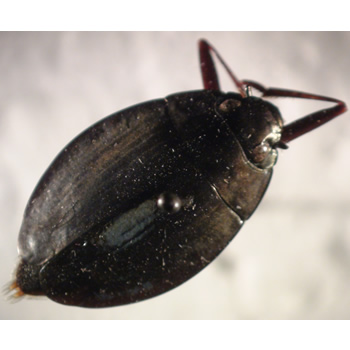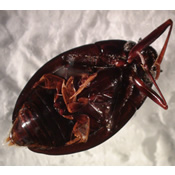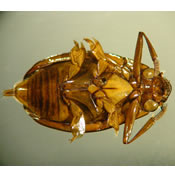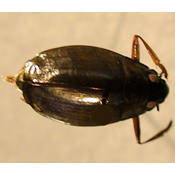| |
|
| |
| Distinguishing Characteristics |
- Apical abdominal hooks
- Eyes separated into two portions - upper portion views the above water habitat; lower portion remains submerged and views the submerged aquatic habitat
- The genus Spanglerogyrus , dorsal and ventral eyes converge on the side of the head are separated by a narrow ridge
- Short, clubbed antennae
- Abdomen Segments 1-9 have lateral hooks
|
| Additional
Pictures |
|
|
| Ecology |
Geographic Distribution:
There are 60 species of Gyrinidae in the United States and Canada (1).
The genera Dineutus and Gyrinus are most diverse and are widespread across North America. Spanglerogyrus has only one species which inhabits lakes in the South and East (1).
Habitats:
Gyrinidae (Whirligig Beetles) are a familiar sight on freshwater ponds, lakes, open flowing streams, bog pools and swamps. They may be found in large aggregations or schools in late summer and autumn, which can be made up of a single species or many different species. Overwinter, pond-inhabiting species often fly to large streams and lakes (1).
Life History:
Mating takes place on the surface. Eggs are attached to underwater vegetation under the water surface (1). There are 3 instars after 1-2 weeks. Larvae pupate on the shore (1). Dineutes assimilis begins to aggregate in large groups in early summer after the mating season has ended; indicating that group behavior is not related to finding a mate (2).
Genetics and Evolution:
Gyrinidae is a large family with some 700 recognized species (1). The 60 species in North America include the genera Dineutus (14), Cyretes (41), Gyrinus (4) and Spanglerogyrus. Divided vision, chemical defenses, and quick swimming movements allow them to avoid predators from above or below (1).
Feeding Ecology:
The Gyrinidae are mainly scavengers, feeding on predators that feed on trapped or floating insects (1).
Physiological Ecology:
Unique divided eyes permit Gyrinidae to see above and below water both at the same time (1).
Gyrinids use a chemical defense mechanism by secreting gyrinidal (a terpene-based substance containing sesquiterpenoid aldehyde), whose distasteful odor deters many predators. Fish apparently learn to reject whirligigs on sight after eating Gyrinidae that are secreting gyrinidal (1,3). G. aerates in Sweden displayed an alarm response when gyrinidal was spread through the water, providing evidence that the secretion acts as a chemical alarm system (4).
A special organ located in the antennae of Gyrinidae, called the Johnstonís organ, receives disturbances in the water. This allows the beetles to signal the presence of a threat to others in the group (3).
Larvae have apical abdominal hooks that let them crawl on objects under the water.
Behavioral Ecology:
Gyrinidae are fast swimmers and will swim in circles when alarmed. They will dive and swim under water to avoid predators (1).
Dineutes assimilis scavenge individually at night and form groups during the day (2). The species changes its grouping behavior according to external temperatures and how hungry they are. In colder temperatures the beetles were more likely to form groups. However, even in cold temperatures hungry beetles remained on the outskirts of a group where they had increased chances of finding food (2).
Dineutes discolor in the Rasquette River in New York State were found to aggregate more tightly in fast water than in slow water (4). There was a significant distance between how male and females stratified within the group. In slow waters, males were at the front of the group, whereas in fast waters females had more forward positions as larger males drifted back to conserve energy. Hungry individuals arranged themselves toward the front (males positioned farther back than females) in both types of water (4).
Temperature and Feeding Vs. Grouping:
Dineutes assimilis, when well fed were observed in groups more frequently at low temperatures. Grouped beetles were less active at high temperatures compared to non-grouped beetles with activity levels relatively constant and independent to temperature change. The benefit of grouping in cold conditions is to reduce the risk of predation because the cold decreases reaction time of individuals. Hungry beetles were observed solo to better enhance foraging methods. The study suggests that hungry beetles should leave groups because the benefit of food outweighs the cost of a potential predation encounter (4).
|
| QuickTime Movies |
Gryinidae.mov- Gyrinidae behavior
|
| Additional Links |
|
| Bibliography |
(1) Merritt, R.W. and K.W. Cummins, An introduction to the aquatic insects of North America 2008: Kendall/Hunt.
(2) Romey, W.L. and D.S. Rossman, Temperature and Hunger Alter Grouping Trade-Offs in Whirligig Beetles. American Midland Naturalist, 1995. 134(1): p. 51-62.
(3) Henrikson, B.-I. and J.A.E. Stenson, Alarm Substance in Gyrinus aeratus (Coleoptera, Gyrinidae). Oecologia, 1993. 93(2): p. 191-194.
(4) Romey, W.L. and E. Galbraith, Optimal group positioning after a predator attack: the influence of speed, sex, and satiation within mobile whirligig swarms. Behavioral Ecology, 2008. 19(2): p. 338-343.
|
|



